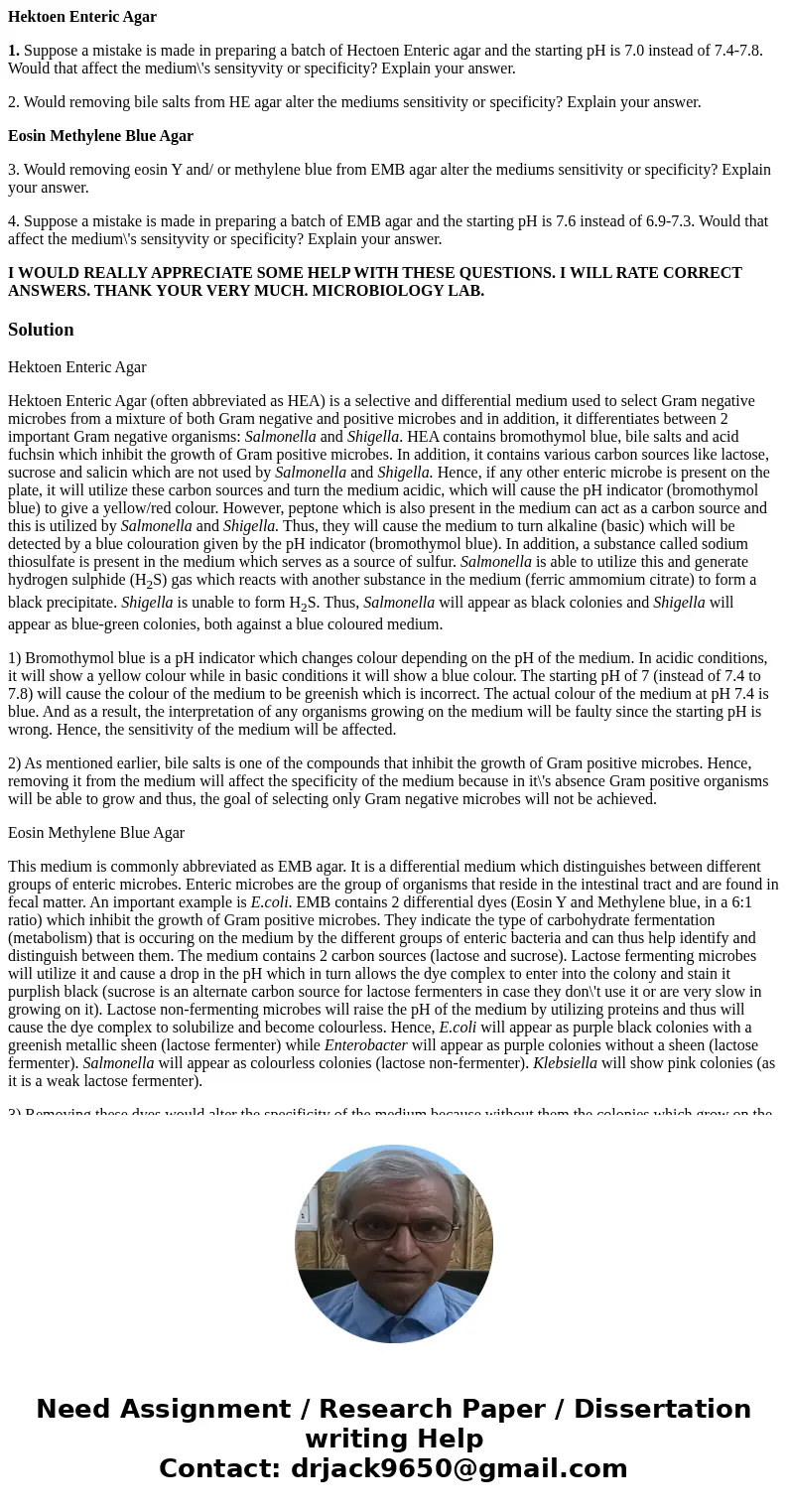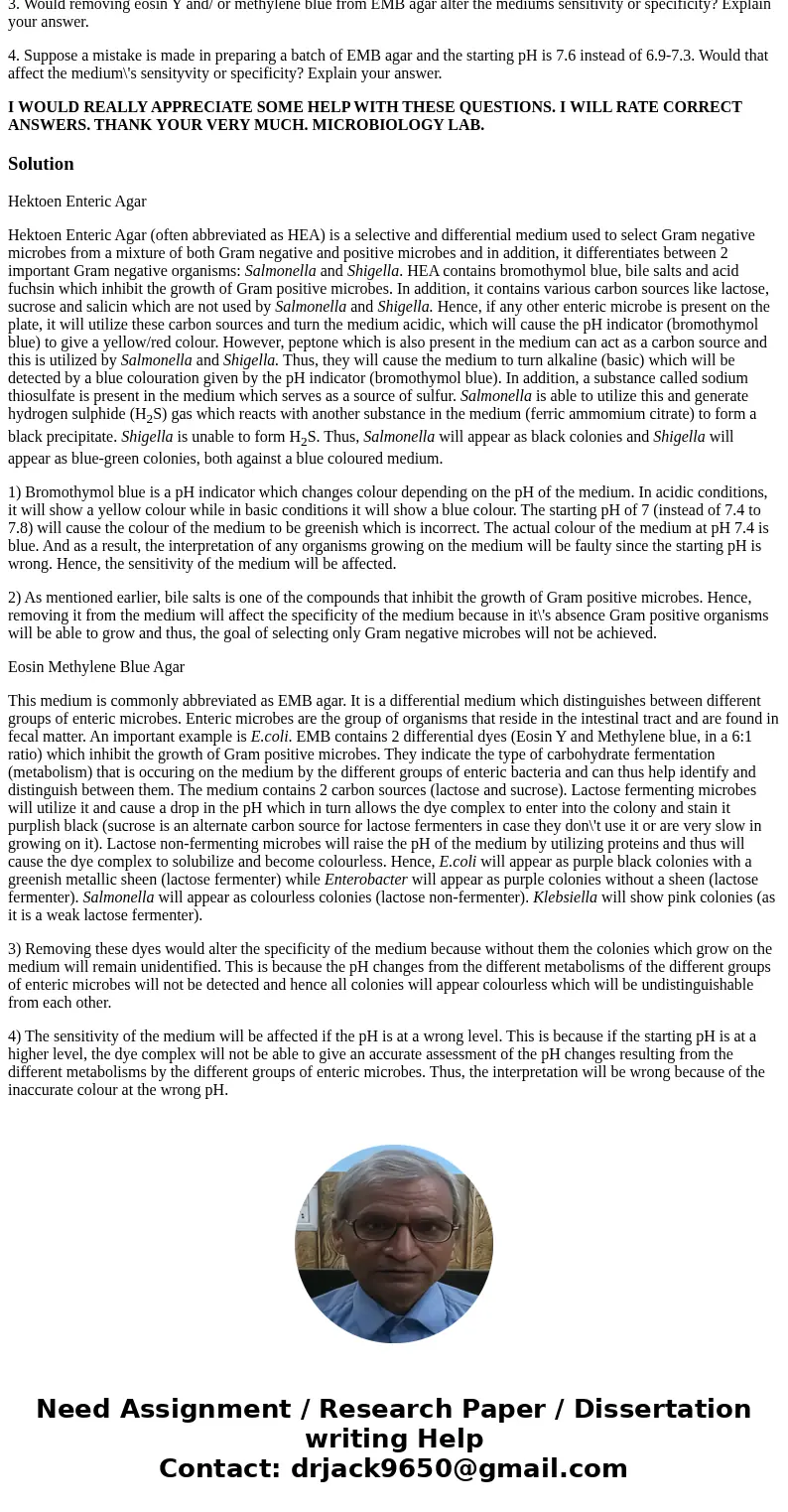Hektoen Enteric Agar 1 Suppose a mistake is made in preparin
Hektoen Enteric Agar
1. Suppose a mistake is made in preparing a batch of Hectoen Enteric agar and the starting pH is 7.0 instead of 7.4-7.8. Would that affect the medium\'s sensityvity or specificity? Explain your answer.
2. Would removing bile salts from HE agar alter the mediums sensitivity or specificity? Explain your answer.
Eosin Methylene Blue Agar
3. Would removing eosin Y and/ or methylene blue from EMB agar alter the mediums sensitivity or specificity? Explain your answer.
4. Suppose a mistake is made in preparing a batch of EMB agar and the starting pH is 7.6 instead of 6.9-7.3. Would that affect the medium\'s sensityvity or specificity? Explain your answer.
I WOULD REALLY APPRECIATE SOME HELP WITH THESE QUESTIONS. I WILL RATE CORRECT ANSWERS. THANK YOUR VERY MUCH. MICROBIOLOGY LAB.
Solution
Hektoen Enteric Agar
Hektoen Enteric Agar (often abbreviated as HEA) is a selective and differential medium used to select Gram negative microbes from a mixture of both Gram negative and positive microbes and in addition, it differentiates between 2 important Gram negative organisms: Salmonella and Shigella. HEA contains bromothymol blue, bile salts and acid fuchsin which inhibit the growth of Gram positive microbes. In addition, it contains various carbon sources like lactose, sucrose and salicin which are not used by Salmonella and Shigella. Hence, if any other enteric microbe is present on the plate, it will utilize these carbon sources and turn the medium acidic, which will cause the pH indicator (bromothymol blue) to give a yellow/red colour. However, peptone which is also present in the medium can act as a carbon source and this is utilized by Salmonella and Shigella. Thus, they will cause the medium to turn alkaline (basic) which will be detected by a blue colouration given by the pH indicator (bromothymol blue). In addition, a substance called sodium thiosulfate is present in the medium which serves as a source of sulfur. Salmonella is able to utilize this and generate hydrogen sulphide (H2S) gas which reacts with another substance in the medium (ferric ammomium citrate) to form a black precipitate. Shigella is unable to form H2S. Thus, Salmonella will appear as black colonies and Shigella will appear as blue-green colonies, both against a blue coloured medium.
1) Bromothymol blue is a pH indicator which changes colour depending on the pH of the medium. In acidic conditions, it will show a yellow colour while in basic conditions it will show a blue colour. The starting pH of 7 (instead of 7.4 to 7.8) will cause the colour of the medium to be greenish which is incorrect. The actual colour of the medium at pH 7.4 is blue. And as a result, the interpretation of any organisms growing on the medium will be faulty since the starting pH is wrong. Hence, the sensitivity of the medium will be affected.
2) As mentioned earlier, bile salts is one of the compounds that inhibit the growth of Gram positive microbes. Hence, removing it from the medium will affect the specificity of the medium because in it\'s absence Gram positive organisms will be able to grow and thus, the goal of selecting only Gram negative microbes will not be achieved.
Eosin Methylene Blue Agar
This medium is commonly abbreviated as EMB agar. It is a differential medium which distinguishes between different groups of enteric microbes. Enteric microbes are the group of organisms that reside in the intestinal tract and are found in fecal matter. An important example is E.coli. EMB contains 2 differential dyes (Eosin Y and Methylene blue, in a 6:1 ratio) which inhibit the growth of Gram positive microbes. They indicate the type of carbohydrate fermentation (metabolism) that is occuring on the medium by the different groups of enteric bacteria and can thus help identify and distinguish between them. The medium contains 2 carbon sources (lactose and sucrose). Lactose fermenting microbes will utilize it and cause a drop in the pH which in turn allows the dye complex to enter into the colony and stain it purplish black (sucrose is an alternate carbon source for lactose fermenters in case they don\'t use it or are very slow in growing on it). Lactose non-fermenting microbes will raise the pH of the medium by utilizing proteins and thus will cause the dye complex to solubilize and become colourless. Hence, E.coli will appear as purple black colonies with a greenish metallic sheen (lactose fermenter) while Enterobacter will appear as purple colonies without a sheen (lactose fermenter). Salmonella will appear as colourless colonies (lactose non-fermenter). Klebsiella will show pink colonies (as it is a weak lactose fermenter).
3) Removing these dyes would alter the specificity of the medium because without them the colonies which grow on the medium will remain unidentified. This is because the pH changes from the different metabolisms of the different groups of enteric microbes will not be detected and hence all colonies will appear colourless which will be undistinguishable from each other.
4) The sensitivity of the medium will be affected if the pH is at a wrong level. This is because if the starting pH is at a higher level, the dye complex will not be able to give an accurate assessment of the pH changes resulting from the different metabolisms by the different groups of enteric microbes. Thus, the interpretation will be wrong because of the inaccurate colour at the wrong pH.


 Homework Sourse
Homework Sourse